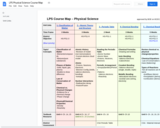
Grades 9-12 Regular Physical Science Scope & Sequence
- Subject:
- Physical Science
- Material Type:
- Full Course
- Provider:
- Liberty Public Schools
- Date Added:
- 08/15/2017

Grades 9-12 Regular Physical Science Scope & Sequence
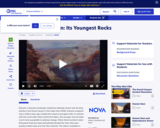
This video segment adapted from NOVA features the youngest rock formations in the Grand Canyon, lava dams, and how they are subject to the eroding power of water.

In this activity, students work in groups to create a presentation that illustrates the meaning of the statement "To make an apple pie from scratch you must first invent the universe." Students pick an element that can be found in apple pie and trace its evolutionary history back to the birth of the universe itself. They also share their vision of the environment in which that element may find itself 5 or so billion years from now after the Earth is long gone. Presentations are intended to demonstrate student understanding of the origins and life cycle of matter, so this activity is appropriate as a conclusion to a unit. This activity is part of the "What is Your Cosmic Connection to the Elements" information and activity booklet. The booklet includes teacher notes, grading guide and student handouts.

This is a lesson about visual spectra. Learners will explore different ways of displaying visual spectra, including colored "barcode" spectra, like those produced by a diffraction grating, and line plots displaying intensity versus color, or wavelength. Students learn that a diffraction grating acts like a prism, bending light into its component colors. The activity is part of Project Spectra, a science and engineering program for middle-high school students, focusing on how light is used to explore the Solar System.
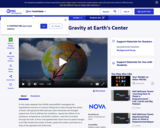
In this video segment from NOVA scienceNOW, learn about the effects of gravity as astrophysicist Neil deGrasse Tyson falls through a virtual hole through Earth's center.
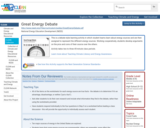
This is a debate-style learning activity in which student teams learn about energy sources and are then assigned to represent the different energy sources. Working cooperatively, students develop arguments on the pros and cons of their source over the others.
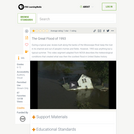
In this video segment adapted from NOVA, a meteorologist explains how an unusual weather pattern led to one of the most devastating floods of this century.
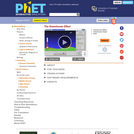
How do greenhouse gases affect the climate? Explore the atmosphere during the ice age and today. What happens when you add clouds? Change the greenhouse gas concentration and see how the temperature changes. Then compare to the effect of glass panes. Zoom in and see how light interacts with molecules. Do all atmospheric gases contribute to the greenhouse effect?
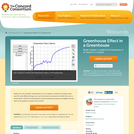
Build your own miniature "greenhouse" out of a plastic container and plastic wrap, and fill it with different things such as dirt and sand to observe the effect this has on temperature. Monitor the temperature using temperature probes and digitally plot the data on the graphs provided in the activity.

Explore how the Earth's atmosphere affects the energy balance between incoming and outgoing radiation. Using an interactive model, adjust realistic parameters such as how many clouds are present or how much carbon dioxide is in the air, and watch how these factors affect the global temperature.
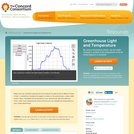
Make your own miniature greenhouse and measure the light levels at different "times of day"--modeled by changing the angle of a lamp on the greenhouse--using a light sensor. Next, investigate the temperature in your greenhouse with and without a cover. Learn how a greenhouse works and how you can regulate the temperature in your model greenhouse.
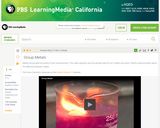
Metals are grouped according to their characteristics. This video segment uses the periodic table for an in-depth discussion.
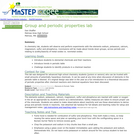
Students will observe and perform experiments with the elements sodium, potassium, calcium, magnesium, sulfur and phosphorus. Conclusions will be made about trends down groups, across periods and relating to acidity/basicity of metal oxides vs. nonmetal oxides

In this activity, students will learn the location of the following categories on the periodic table while creating their own version including a key.Categories Included:Alkali MetalsAlkaline Earth MetalsHalogensNoble GasesMetalsNonmetalsMetalloidsTransition MetalsInner Transition MetalsThe Soft Chalk Activity includes interactive checks throughout and includes information on valence electrons and determining groups and periods for elements.
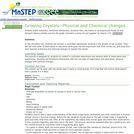
This activity is a classroom lab where students will conduct a controlled activity resulting in the growth of salt crystals, showing a dramatic physical change.
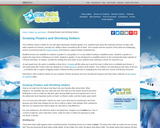
This expository article, written for students in grades 4-5, explains why ice floats and how this is essential to life on earth. Modified versions are available for younger students.
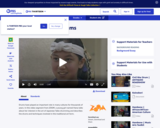
In this ZOOM video segment, join Hana as she learns traditional Japanese drumming with her Taiko group.
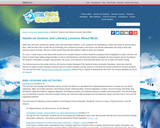
This article provides links to lessons and units about birds, bird characteristics, and penguins. Ideas for literacy integration are included, and all lessons are aligned to national standards.

Using inquiry-focused reading, students will explore an anchor text and supporting resources to investigate the principles of transfer of heat energy with applications of the concept to solve real world problems.
The instructors will prepare a sample presentation and model for students the steps taken to go from a text to the final project. Students will learn annotations, two column notes, and citations, while learning about how chemistry is used to solve real world problems based on the instructor provided materials. The students will then apply those concepts to a different project assigned by the instructors and apply the same strategies to their own texts to demonstrate their application of learning to a different problem.
Over the course of the unit, students will explore a variety of resources to develop their knowledge of heat energy changes that accompany physical and chemical reactions, measurement of heat energy, and heat energy transfer between the system and the surroundings. They will expand their ability to use informational text to support their inquiry and research, explore scientific literature, and develop questions to determine how the application of energy transfer principles can be applied to solve real world problems.

Using inquiry-focused reading, students will explore an anchor text and supporting resources to investigate the principles of transfer of heat energy with applications of the concept to solve real world problems.